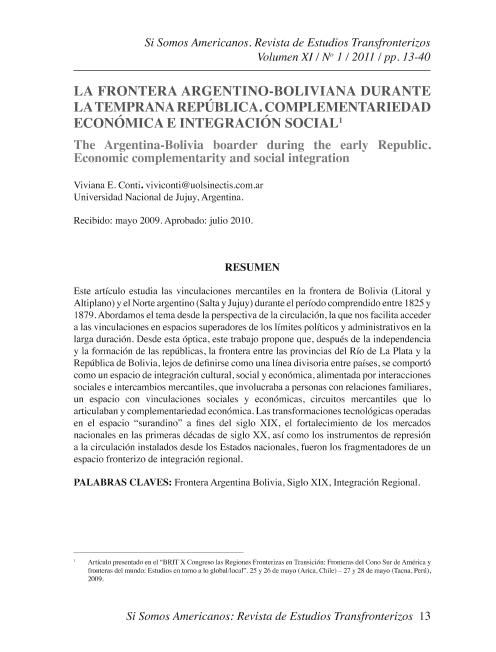Artículo
Este artículo estudia las vinculaciones mercantiles en la frontera de Bolivia (Litoral y Altiplano) y el Norte argentino (Salta y Jujuy) durante el período comprendido entre 1825 y 1879. Abordamos el tema desde la perspectiva de la circulación, la que nos facilita acceder a las vinculaciones en espacios superadores de los límites políticos y administrativos en la larga duración. Desde esta óptica, este trabajo propone que, después de la independencia y la formación de las repúblicas, la frontera entre las provincias del Río de La Plata y la República de Bolivia, lejos de definirse como una línea divisoria entre países, se comportó como un espacio de integración cultural, social y económica, alimentada por interacciones sociales e intercambios mercantiles, que involucraba a personas con relaciones familiares, un espacio con vinculaciones sociales y económicas, circuitos mercantiles que lo articulaban y complementariedad económica. Las transformaciones tecnológicas operadas en el espacio “surandino” a fines del siglo XIX, el fortalecimiento de los mercados nacionales en las primeras décadas de siglo XX, así como los instrumentos de represión a la circulación instalados desde los Estados nacionales, fueron los fragmentadores de un espacio fronterizo de integración regional. This article studies the mercantile links at the frontier of Bolivia (Coast and Highland) and the Argentinean North (Salta and Jujuy) in the period between 1825 and 1879. We approach the topic from the perspective of the circulation, which enables us to see the links in areas, beyond the political and administrative limits in the long time. From this view, this work proposes that, after the Independence and the formation of the republics, the border between the Provinces of the River Plate and the Republic of Bolivia -far from being defi ned as a dividing line among countries- it behaved as a space of cultural, social and economic integration, enlarged by social interactions and mercantile exchanges that involved people with family relationships, a space with social and economic links, mercantile circuits which articulated it and complementary economics. The technological transformations operated in the “surandina” area at the end of the XIX Century, the strengthening of the domestic markets in the fi rst decades of XX Century, as well as the instruments of repression to the circulation installed from the national States, made the border space of the region disintegrate.
La frontera argentino-boliviana durante la temprana república: complementariedad económica e integración social
Título:
The Argentina-Bolivia boarder during the early Republic: economic complementarity and social integration
Fecha de publicación:
12/2011
Editorial:
Universidad Arturo Prat. Instituto de Estudios Internacionales
Revista:
Si Somos Americanos
ISSN:
0718-2910
Idioma:
Español
Tipo de recurso:
Artículo publicado
Clasificación temática:
Resumen
Palabras clave:
FRONTERA
,
ARGENTINA-BOLIVIA
,
SIGLO XIX
,
INTEGRACION
Archivos asociados
Licencia
Identificadores
Colecciones
Articulos (ISHIR)
Articulos de INVESTIGACIONES SOCIO-HISTORICAS REGIONALES
Articulos de INVESTIGACIONES SOCIO-HISTORICAS REGIONALES
Citación
Conti, Viviana Edith; La frontera argentino-boliviana durante la temprana república: complementariedad económica e integración social; Universidad Arturo Prat. Instituto de Estudios Internacionales; Si Somos Americanos; 11; 1; 12-2011; 13-40
Compartir




